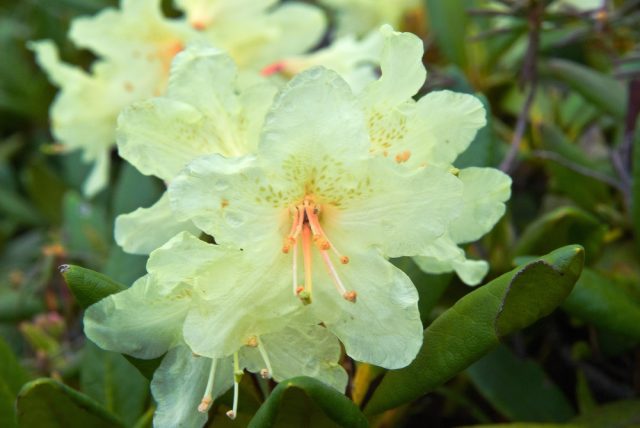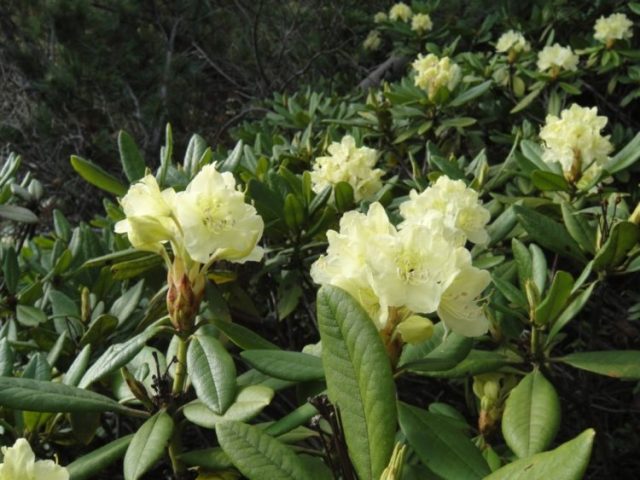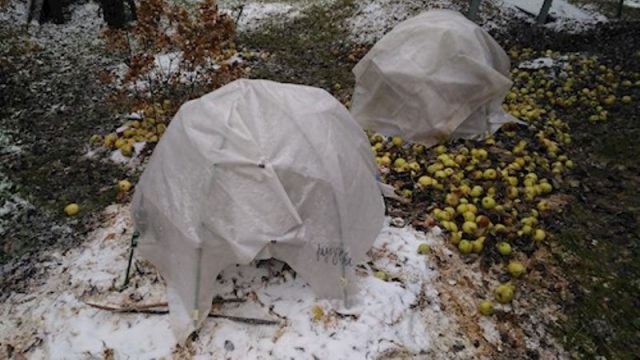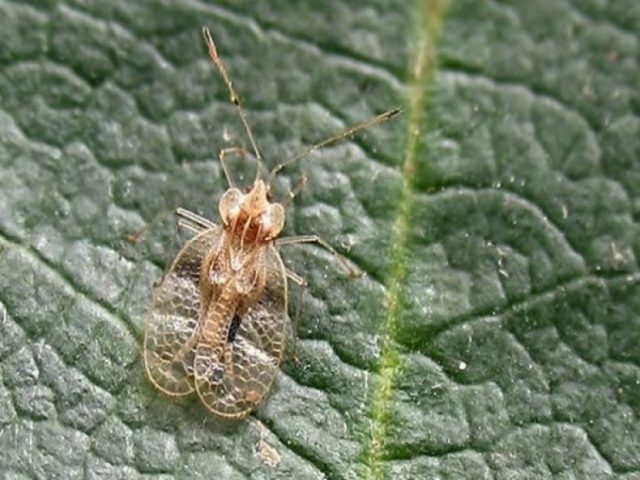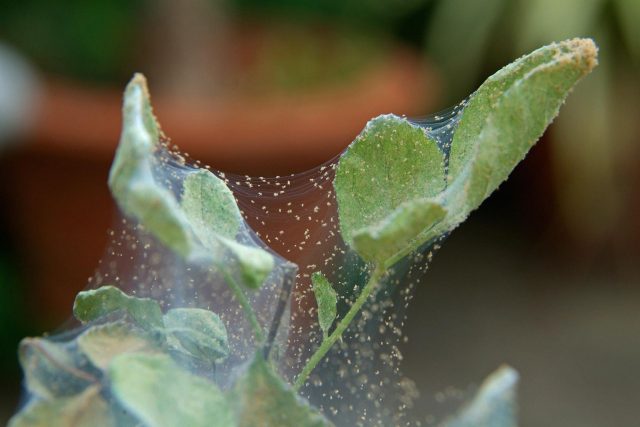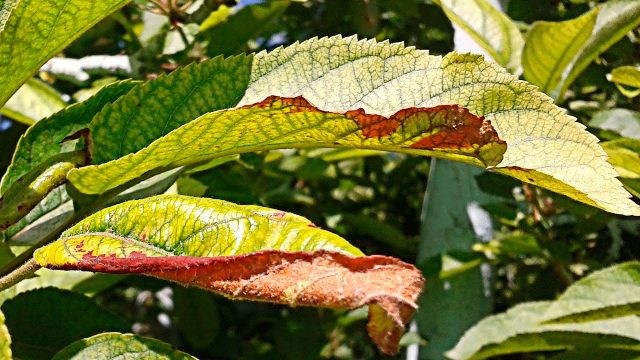Content
Rhododendron golden, or, as it is called in Siberia, kashkara or black mane, refers to perennial, frost-resistant, low shrubs from the Heather family. Thanks to its beautiful and long-lasting flowering, the plant has found wide application in the design of a personal plot. In addition to being highly decorative, golden rhododendron has medicinal properties. A decoction of the leaves and medicinal tea are used in the treatment of infectious and pulmonary diseases.
Description of golden rhododendron
Rhododendron golden is an evergreen, perennial plant that grows in the Far East and Siberia. Prefers moist soil, rocky slopes and areas under the canopy of cedar forests.
Rhododendron golden is a small plant, no more than 1 m in size. The spreading crown is formed by brown shoots covered with leathery, dark emerald leaves. At the beginning of summer, large flowers up to 5 cm in diameter appear at the ends of the shoots, collected in 3-5 pieces. A cherry-red or orange stigma column is surrounded by pale lemon speckled petals. This combination of colors makes the golden rhododendron even more decorative. Flowering is long, lasts 30-45 days.
After flowering, seed pods with small seeds appear on the golden rhododendron. To extend the flowering period, faded inflorescences must be removed in a timely manner so that the plant does not waste energy on seed ripening. All the beauty of golden rhododendron can be seen in the photo:
Why is golden rhododendron (kashkara) useful?
Rhododendron golden has medicinal properties, it is widely used in home life:
- rhododendron petals help get rid of barley on the eye and eliminate diaper rash;
- leaf tincture is recommended for migraine, insomnia and neurosis;
- essential oils with a pleasant aroma are obtained from the plant, which are used in aromatherapy;
- golden rhododendron is used in the shoe industry as a tannin;
- in the household, flowers are used as a remedy for moths.
Application of rhododendron golden
Rhododendron golden is used in folk medicine. But before using a medicinal medicine, you need to know the medicinal properties and contraindications of golden rhododendron.
For the preparation of medicinal infusions, tinctures and decoctions, the collection of flowers and leaves is carried out from a 2-3-year-old plant, from late May to mid-June. The workpiece is carefully removed from the bush and dried in the fresh air under a canopy. The raw materials are laid out in 1 layer, stirring occasionally for uniform drying.
Preparations prepared on the basis of rhododendron have bactericidal, anti-inflammatory, diuretic and tonic properties. Infusions, tinctures and decoctions are recommended for the following diseases:
- hypertension;
- stomatitis and gum disease;
- with erosion of the cervix;
- colds;
- skin diseases;
- colitis, enterocolitis and enteritis.
In homeopathy, golden rhododendron is used:
- with severe symptoms of gout and rheumatism, which appear in a hot time before a thunderstorm;
- with headaches and joint pains that worsen in cold and rainy weather;
- with hearing loss with ringing in the ears;
- with trigeminal neuralgia, toothache, gum disease;
- with stitching pains in the spleen, which are aggravated by brisk walking;
- with joint pain that worsens when walking or when the weather changes.
Recipes for the use of golden rhododendron in traditional medicine:
- Infusion for colds and infectious diseases - 1 tbsp. l. crushed dried leaves are poured into a glass of boiled, hot water and insisted for about 1 hour. Apply 1 tsp. 4 times a day for 3-5 days. With the same infusion, you can treat purulent wounds, treat boils and carbuncles.
- Tincture for radiculitis - 3 tbsp are poured into 500 ml of vodka. l. dry leaves. The bottle is removed in a dark place and insisted for about 2 weeks. Take 3-4 times a day after meals, diluting the tincture with water in a ratio of 1: 4.
Contraindications to golden rhododendron
Despite the large number of useful properties, one must not forget that golden rhododendron is a poisonous plant and therefore has a number of contraindications.
The honey obtained from rhododendron flowers is very toxic, so when consuming 2-3 tbsp. l. diarrhea, vomiting, fever and heart failure may develop, up to and including loss of consciousness.
The medicine from rhododendron golden is contraindicated:
- pregnant and lactating women;
- hypotension;
- people with chronic renal and hepatic diseases;
- children under 15 years old.
In case of an overdose of a natural medicine, headache, nausea and vomiting may appear, a decrease in blood pressure, impaired cardiac activity, shortness of breath and suffocation are characteristic. If one of the symptoms appears, an ambulance must be urgently called. Before the arrival of doctors, the patient must be laid down, unbuttoned tight clothing, open the vents for fresh air, give activated charcoal at the rate of 1 tablet per kg of weight.
Cultivation of golden rhododendron
In order for the golden rhododendron to grow and develop well, not to be exposed to diseases and pests, you need to know the rules of planting and care. Subject to the rules, the undersized golden rhododendron will be perfectly combined with conifers, in rock gardens, in rocky gardens, in single and group plantings.
Selection and preparation of the landing site
Rhododendron golden prefers to grow on fertile, well-drained soil without stagnant water, in a shaded area with diffused light. Rhododendron will grow well among apple and pear trees, since fruit trees have a taproot system, and will not take away nutrients and moisture from the shrub.
Seedling preparation
A seedling of golden rhododendron is best purchased at the age of 2-3 years. When buying, you need to pay attention to the root system, it should be well developed, without signs of rot and mechanical damage. When purchasing a seedling with open roots, before planting, it is soaked for 2-3 hours in warm water with the addition of a root formation stimulator.
Landing rules
Rhododendron golden can be planted in spring and autumn. Spring planting is suitable for regions with an unstable climate, since during the summer season the rhododendron will grow the root system and will better endure the cold winter.
14 days before planting a young rhododendron, it is necessary to prepare a planting pit. For this, a place is dug onto a shovel bayonet, rotted compost, bark of coniferous trees and sod land are introduced. With increased acidity, slaked lime or dolomite flour is added during digging. If several specimens are planted, the interval between the holes is maintained at 1-1.5 m. Planting of golden rhododendron:
- A 15 cm layer of drainage (expanded clay, broken brick or small pebbles) is laid out in a landing pit 60x40 cm in size.
- Drainage is sprinkled with nutritious soil in the form of a mound.
- The root system of the seedling is carefully straightened and placed on a prepared mound, so that the root collar is located at ground level.
- Rhododendron is sprinkled with earth, tamping each layer so that no air space remains.
- The planted plant is abundantly shed and mulched. The mulch will retain moisture, save the root system from overheating, and stop weeds from growing.
Without timely care, you cannot achieve a beautiful and lush flowering. Care consists in timely watering and feeding, sanitary and formative pruning, as well as in taking preventive measures against diseases and pests.
Watering and feeding
To lay flower buds, a rhododendron needs enough moisture to moisten the soil by 20-30 cm. Irrigation is carried out in the morning or evening. For each adult plant, up to 10 liters of warm, settled water are consumed. In order for the foliage to shine and look decorative, the bush must be sprayed in a dry summer, after sunset.
To obtain lush flowering, golden rhododendron needs nutritious soil. To do this, in the second year after planting, liquid fertilizers are applied under the bush 2-3 times per season:
- in the spring, before bud break, use nitrogenous top dressing;
- during flowering - complex mineral fertilizers;
- 2 weeks before frost - phosphorus-potassium fertilizing.
Lack of nutrients, as well as excess, negatively affects the growth and development of golden rhododendron. Lack of nutrition can be determined by the appearance of the bush:
- the sheet plate is discolored;
- growth and development slows down;
- the formation of buds is minimal;
- the shrub loses its attractiveness.
Pruning
The golden rhododendron does not need formative pruning, since the plant can independently form a spherical crown. But so that the bush does not lose its decorative appearance and fungal diseases do not join it, it is necessary to carry out sanitary pruning. In spring and autumn, they get rid of frozen, dry and overgrown shoots.
In order for the golden rhododendron to show lush flowering from year to year, all faded inflorescences must be broken out in a timely manner so that the plant does not waste energy on seed ripening.
Preparing for winter
Kashkara blackmane or golden rhododendron is a frost-hardy plant that can withstand cold temperatures down to -25 ° C. But in order not to lose a flowering specimen, a young plant must be covered for 3 years after planting. For this:
- 2 weeks before frost, rhododendron is abundantly shed and fed with phosphorus-potassium fertilizers.
- To protect the root system from frost, the trunk circle is mulched.
- After the air temperature drops to the minus mark, the branches are shifted with spruce branches and pulled together with twine.
- The crown is covered with burlap or agrofibre.
- The shelter is removed after the snow melts, in cloudy weather.
Reproduction
Rhododendron golden is often propagated by cuttings, branches and dividing the bush.
Taps - in the spring, the lower branch is laid in a trench, leaving the top above the surface. Fall asleep with nutritious soil, spill and mulch abundantly.After a year, the shoot will take root, it can be separated from the mother bush and transplanted to a prepared place.
Cuttings - after flowering, shoots 10-15 cm long are cut from the top of the bush. The planting material is kept in a root formation stimulator and planted at an acute angle in a nutritious soil. For fast rooting, cuttings need to create a greenhouse effect. When new foliage appears, the cuttings are seated in separate containers of a larger volume. For the winter, the plant is transferred to a cool room, not forgetting to irrigate regularly.
Dividing the bush - after rejuvenating pruning, the plant is carefully dug out, being careful not to damage the surface roots. The bush is divided into sections, so that each part has healthy roots and a growth bud. Young plants are planted, and subject to agrotechnical rules, they will quickly grow and at the end of spring they will show themselves in all their glory.
Diseases and pests
Rhododendron golden has immunity to diseases and pests. But if the rules of care are not followed, the plant may appear:
- Rhododendron bug - the pest often appears on the inside of the leaf plate. Without treatment, foliage dries up and falls off. Treatment consists of spraying the shrubs with broad-spectrum insecticides.
- Spider mite - appears on the plant in hot, dry weather. The pest sucks the sap from the plant and covers the entire ground part with a thin web. You can get rid of the insect by spraying 2-3 times with the preparation "Aktar".
- Chlorosis - the disease appears when the rules of care are not followed and when the plant is grown on acidified soil. The first signs of the disease are the appearance of red or yellow spots on the leaf plate.
In order to prevent the shrub, it is necessary to treat it 2 times a season with Bordeaux liquid, to carry out timely care and sanitary pruning.
Conclusion
Golden rhododendron is a godsend for flower growers, since the plant will become an adornment of the personal plot and will help against many diseases. The shrub is unpretentious, frost-hardy and, due to its low height, looks great in rock gardens, rocky gardens and among conifers and ornamental plants.
